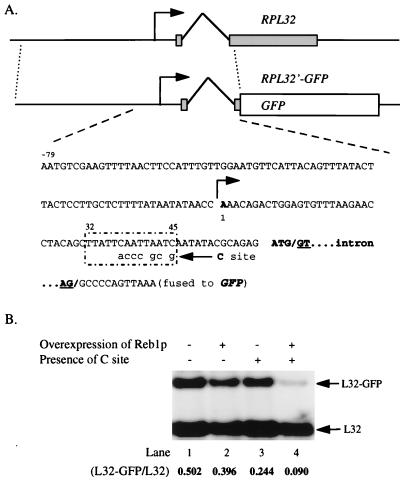FIG. 6.
Reb1p bound at the C site can block transcription of a heterologous promoter. (A) Diagram and partial sequence of the reporter genes. An 860-bp fragment of RPL32 of S. cerevisiae fused to GFP was used as the backbone for the reporter gene, pLC151 (pRS314-RPL32′-GFP). The transcription initiation site is indicated as 1 (11). The nucleotides designating the 5′ (GT) and 3′ (AG) sites of the RPL32 intron are underlined. By substitution of only seven nucleotides it was possible to generate a sequence identical to the original C site over 14 bp at positions +32 to +45 of the RPL32 transcription unit, as shown in the box. The resulting reporter gene was designated pLC151C. (B) Decreased transcription of RPL32′-GFP by Reb1p binding to the C site. Total RNA prepared from WY189 (with pLC151, lanes 1 and 2) and WY190 (with pLC151C, lanes 3 and 4) were subjected to Northern blot analysis and probed with an end-labeled oligonucleotide (JW969 [+31 to +10]; panel A) that will detect transcripts of both RPL32 and RPL32′-GFP (arrows). Both strains contained pLC30 (pGAL1-REB1, see Tables 1 and 2), in which overexpression of Reb1p can be induced by using galactose as the carbon source (lanes 2 and 4). The relative amounts of the two mRNAs, as determined by PhosphorImager analysis, are indicated. Three independent clones from each strain were used for this set of experiments. One representative example of each strain is shown.

